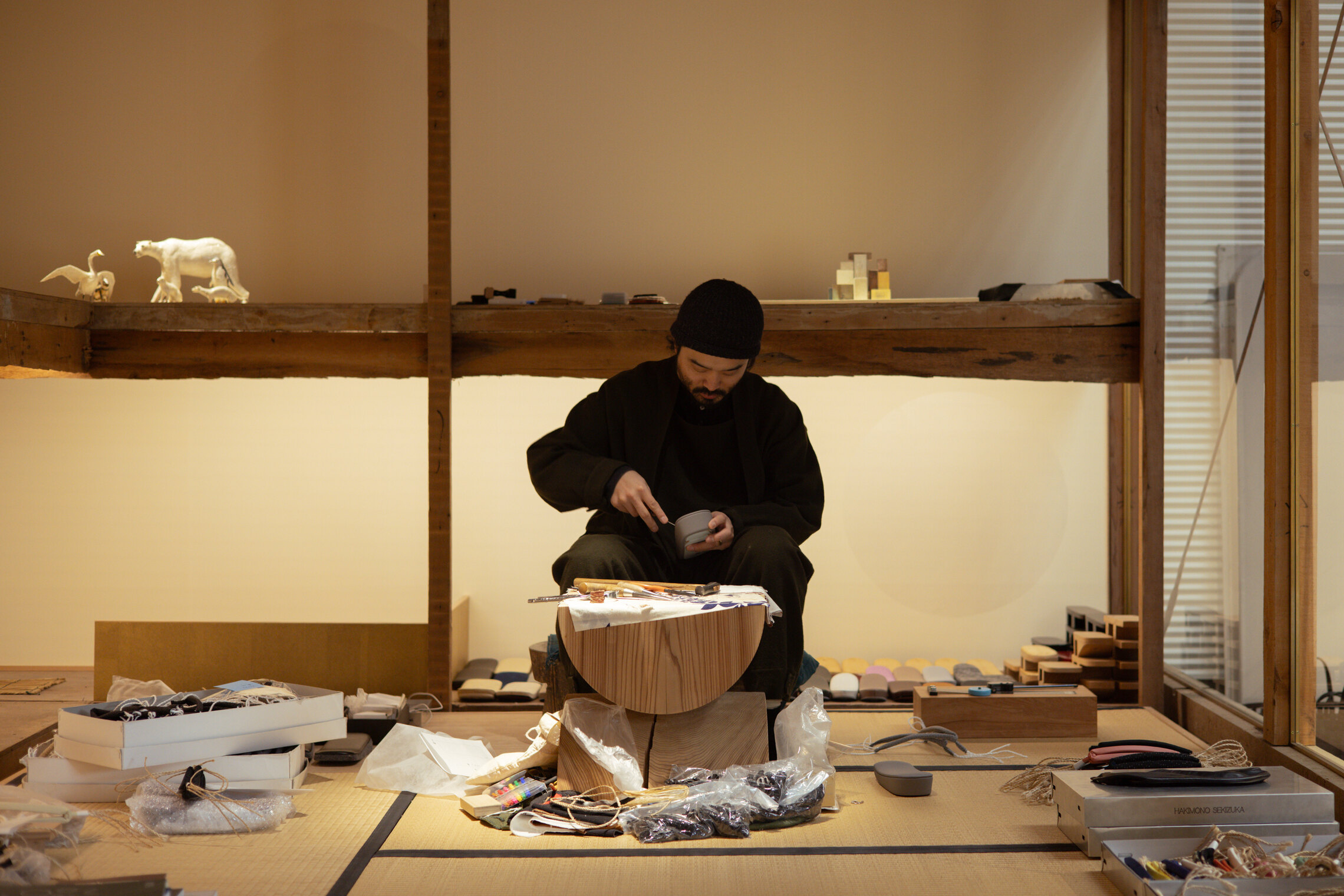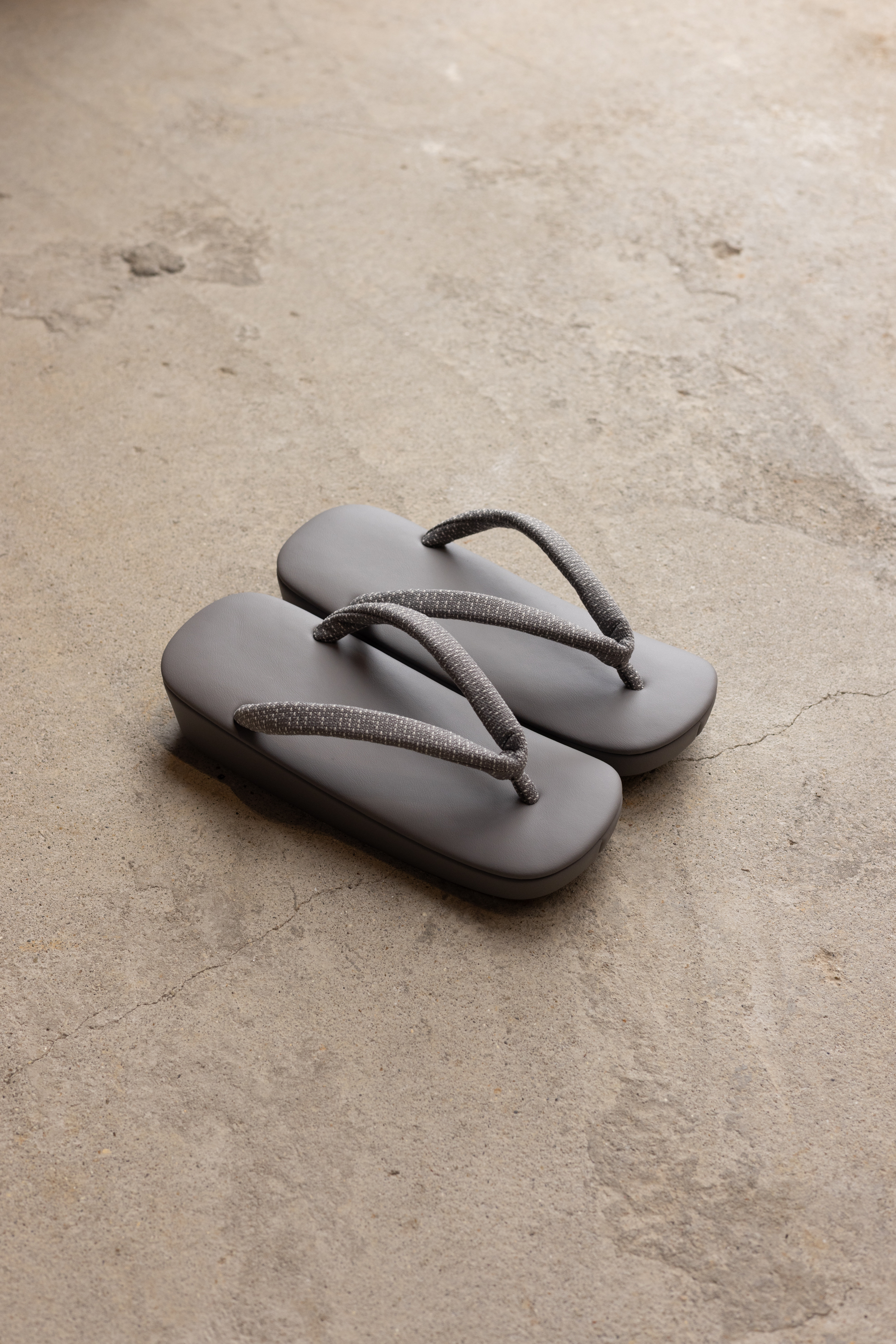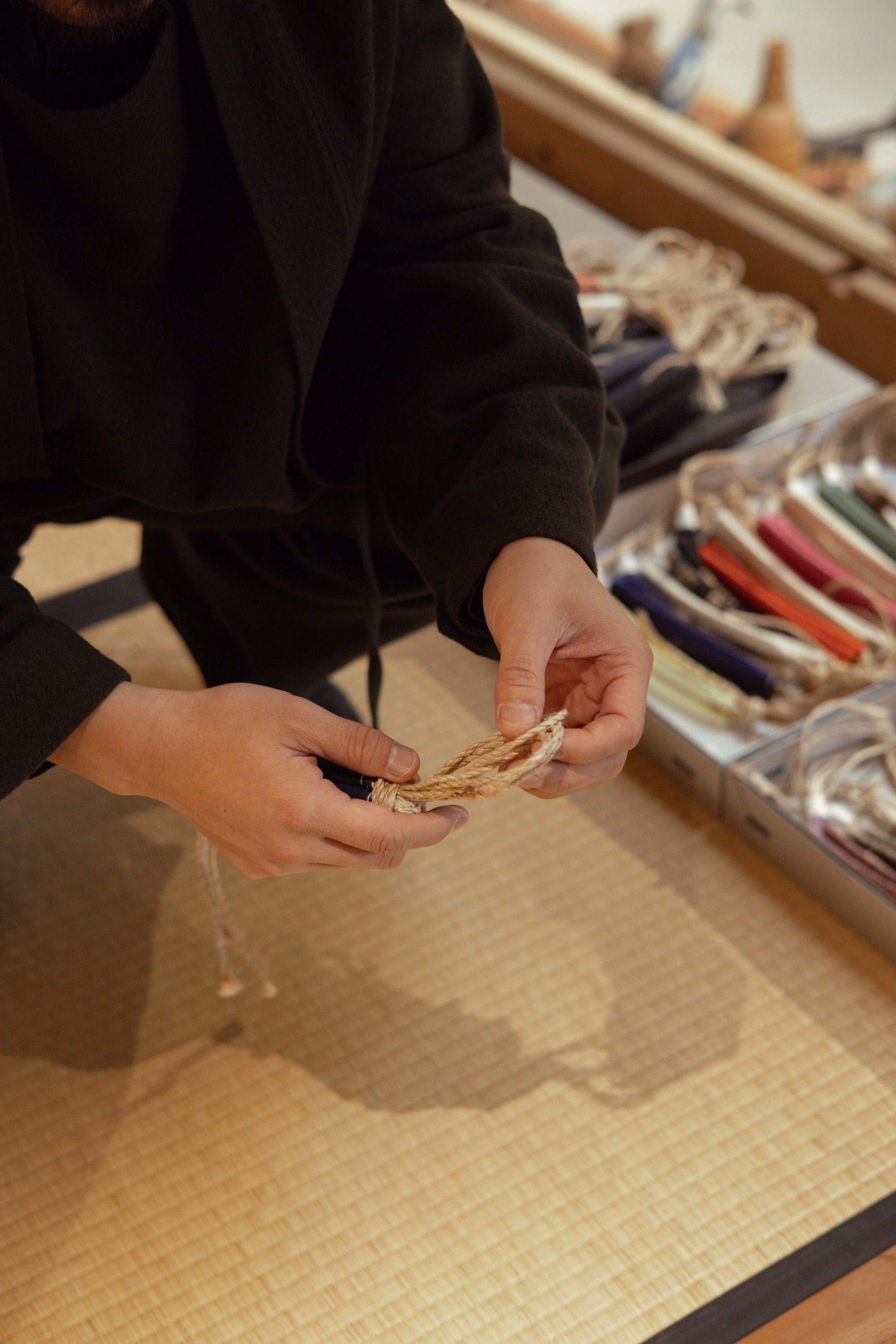





Conversation with Shinji Sekizuka (Hakimono Sekizuka) / 素と誂 So to Atsurae (Material and Tailored)
25 Aprilー2 June 2025
Known for crafting footwear that fits seamlessly into everyday life, Hakimono Sekizuka presents a new series of handcrafted zori sandals made with 〈Ame〉 and 〈Haku〉 — textiles designed by Teruhiro Yanagihara Studio for Danish manufacturer Kvadrat. Merging the sensibilities of both creators, each pair is thoughtfully made by hand, one by one.
At VAGUE KOBE, the exhibition and bespoke order event ‘So to Atsurae (Materials and Tailored)’ invites us to contemplate the act of shaping form through dialogue with materials, and the quiet richness found in tailoring. These zori adapt to the wearer’s feet and attire, gradually becoming part of their surroundings — evolving beyond practicality through everyday use.
We spoke with footwear artisan Shinji Sekizuka to learn more about what shaped this collection.
When we visited his workshop in Iwakura, Kyoto, Sekizuka began by showing us the first steps of sandal-making: preparing the hanao (sandal strap). He adjusts the cotton stuffing by hand to achieve just the right thickness, guiding the strap through small holes in the sandal base. This accumulation of delicate handiwork determines the beauty and comfort of each pair.
‘If I removed all the cotton, it would be quite easy to pass the strap through. But it wouldn’t look beautiful. It will look less elegant by enlarging the holes too. I adjust the fullness of the strap by the feeling of my hands — this preparation takes the longest time. Like cooking or architecture, the most time-consuming parts are often the steps you don’t see.’
Behind this careful work lies a sensitivity refined over the years, and a commitment to engaging deeply with materials. Perhaps unexpectedly, Sekizuka’s initial interest in footwear began with a passion for sneakers.
‘I played basketball in primary school and loved collecting basketball shoes. Mostly Nike, like Air Max and Jordans. I was right in the middle of the sneaker boom.’
Sekizuka’s love for sneakers, combined with experience in the shoe industry, sparked a desire to create with his own hands — eventually leading him to discover traditional Japanese footwear.
‘There are so many shoe makers around the world, and I realised that I didn’t want to compete in that space. That’s when I encountered the traditional zori. It only has two parts — a base and a strap. It is so simple, yet so beautiful. Clean, minimal, with nothing excessive. They are like the opposite of sneakers, and that contrast drew me in.’
The open structure of zori — unlike Western shoes that wraps around the foot — resonates with the logic of Japanese architecture and daily life. Though consumable items, they are deeply embedded in culture. Sekizuka’s craft reveals his reverence for this wisdom and aesthetic.
‘Zori are designed to be symmetrical, allowing you to wear them on either foot. This is especially practical in Japan, where people frequently take their shoes on and off. Since zori are made from natural materials, it is possible for one side to wear out before the other. Fortunately, you can simply replace the damaged side instead of discarding the entire pair.’
Our conversation turned to the history of footwear and the circulation of materials.
‘In the late Edo period, when travel became more common, people wore ichirihaki — sandals made of straw that were designed to fall apart after just ichiri (4km). Travellers would typically walk 30km a day. These sandals were biodegradable and could be discarded along the road, and some craftsmen would collect those broken sandals, repair and resell them. It was a wonderful cycle.’
This concept of recycling materials also connects to the Kvadrat textiles used in the exhibition. Inspired by sashiko (traditional hand embroidery and quilting technique) from the Edo period, 〈Ame〉 reinterprets that sense of beauty into a contemporary textile. Its flowing stitches resemble falling rain (or, ame in Japanese), layered with shifting colours drawn from nature and kimono.
‘Even though 〈Ame〉 is made from recycled materials, it doesn’t feel unpleasant to the hand. It has a comforting texture, like sashiko — something nostalgic about it reminds me of traditional Japanese aesthetics.’
Meanwhile, 〈Haku〉 is a silicone-coated textile with waterproof and durable properties. It offers a soft touch and is available in 28 colours.
‘〈Haku〉has an industrial feel, almost like mortar. It is so rigid that it can be quite tough to work with. But that toughness gives it a strong presence as an object.’
At ‘So to Atsurae’, these textiles are used in both custom-made sandals and exclusive edition models created especially for VAGUE. Even within the same zori form, variations in material and colour reveal entirely different expressions. Each pair, tailored to its wearer, begins to reflect their personality and eventually becomes part of their landscape.
As Sekizuka says: ‘Footwear is part of the landscape. It’s not just a tool, but a part of everyday life. Over time, it moulds to the person who wears it — their habits and footsteps all leave their mark on their pair of zori.’
日常に寄り添う履物を提案する〈履物 関づか〉と、Teruhiro Yanagihara Studioがデンマークのテキスタイルメーカー・Kvadrat社のためにデザインした〈Ame〉〈Haku〉。異なる分野で素材と向き合ってきた両者の出会いから、一足一足丁寧に仕立てられた草履が生まれました。
2025年4月25日(金)よりVAGUE KOBEで開催される展示受注会「素と誂(そとあつらえ)」では、素材との対話からかたちを立ち上げるという行為、そして“誂える”という時間の奥行きを改めて見つめ直します。履く人の足や装いに寄り添い、やがて風景の一部となっていく草履。その存在は、道具の域を超えて、日々の暮らしのなかで静かに育まれていきます。
素材に耳を澄ませるように草履を仕立てる職人・関塚真司に、本展に込めた想いを伺いました。
京都・岩倉のアトリエを訪ねた際には、草履づくりのはじまりとも言える鼻緒の“下ごしらえ”から作業を見せてくれました。綿を抜いてふくらみを調整し、台に開けられた小さな穴に鼻緒を通していく——こうした繊細な手仕事の積み重ねが、草履の美しさと履き心地を形づくっていくのだと語ります。
「全部綿を抜いてしまえば、通しやすくて簡単なんですけど、それでは美しくない。穴を大きくしても、綺麗じゃないんです。ぴったり合うふくらみを、手で探りながら調整していく。この下ごしらえの時間が一番長いんです。料理や建築と同じで、見えないところにこそ時間がかかります。」
その丁寧な手仕事の背景には、長年かけて研ぎ澄ませてきた感覚と、時間をかけて素材と向き合う姿勢がありました。そもそも関塚真司が履物に興味を持ったのは、意外にもスニーカーとの出会いがきっかけだったといいます。
「小学生の頃にバスケをやっていて、バスケットシューズを集めるのが趣味でした。エアマックスやジョーダンシリーズなど、ナイキばかり履いていましたね。当時はスニーカーブームの真っ只中で。」
このスニーカーに夢中だった少年は、靴業界での経験を経て、「自分の手で作りたい」という思いを強め、日本の伝統的な履物にたどり着きました。
「世界には靴を作る人がたくさんいるけれど、その競争のなかに飛び込むのは自分じゃないなと思ったんです。そのとき出会ったのが、日本の履物。台に鼻緒を差し込むだけという構造なのに、ものすごく美しい。潔くて、シンプルで、無駄がない。スニーカーとは真逆だけど、だからこそ惹かれたんだと思います。」
足を覆わない草履の構造には、日本の建築や暮らしに通じる合理性が宿っています。また、履物は消耗品でありながら、文化や暮らしとともにある存在。関塚の草履づくりには、そうした知恵と美意識への敬意がにじみ出ています。
「草履は左右対称に作られているから、どちらの足でも履ける。脱ぎ履きの多い日本の暮らしにはとても理にかなっています。天然素材は個体差があるので、片方だけが壊れることもある。でも、草履なら片方だけ作り直せばいいんです。」
さらに話は、履物の歴史や素材の循環へと広がっていきます。
「庶民の旅が広まった江戸後期、“一里履き”という履物が生まれました。1日に30キロも歩く旅の中で、一里、つまり4キロで壊れることを前提に、藁で作られていたんです。壊れたら道端に捨てても自然に還る。そして、それを拾って修理し、売る職人もいました。とても良い循環があったんですよね。」
こうした「素材の循環」という考え方は、今回の展示で使用されているKvadrat社のテキスタイル〈Ame〉〈Haku〉にも通じています。なかでも〈Ame〉は、江戸時代の刺し子から着想を得て、その美意識を再解釈し、現代のテキスタイルへと昇華させた生地です。降り注ぐ雨のような流れるステッチと、着物の重ねや自然の色彩の移ろいが織り込まれています。
「〈Ame〉は再生素材なのに、他と違って不思議と嫌な感じがしない。刺し子のような凹凸があって、どこか懐かしい。日本の古いものに既視感があるんです。」
一方、〈Haku〉はシリコンコーティングによる防水性と耐久性を備えたテキスタイル。繊細な質感とソフトな手触りを持ち、28色の豊かなカラーバリエーションが揃っています。
「〈Haku〉は、モルタルのような科学の力を感じる素材。しっかりしているから、作る側としては手が負けそうになるくらい固い(笑)。でも、それだけ、ものとしての存在感があると思うんです。」
今回VAGUE KOBEで開催される展示受注会「素と誂(そとあつらえ)」では、〈Ame〉〈Haku〉を用いて一足ずつ丁寧に仕立てる誂えの草履に加え、VAGUE別注モデルも展示・販売する予定です。
同じ草履というかたちでも、素材や色が変わるだけで、まったく異なる表情を見せます。それぞれの足に合わせて仕立てられた一足は、履く人の個性を映し出し、やがてその人の風景の一部となっていきます。
関塚は最後にこう語ります。
「履物って、風景なんですね。ただの道具ではなく、暮らしの一部。時間をかけて履く人に馴染んでいく。その人の癖や足跡が、草履にちゃんと刻まれていくんです。」